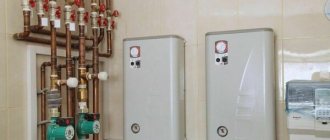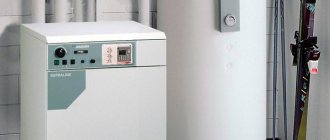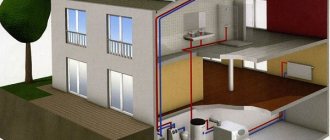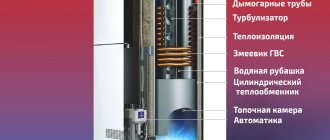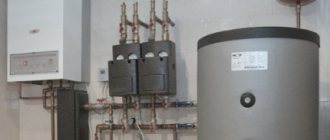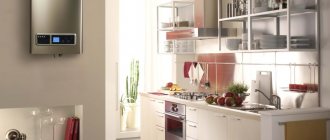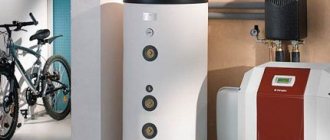Fewer and fewer people are willing to pay extra money for the increased consumption of natural gas consumed when heating a private house or apartment. Hence the demand for economical gas boilers, designed to replace old heating units or take place in boiler rooms of new buildings.
But try to figure out which boilers are the most economical and how to choose the right model among them. Homeowners often fall for the bait of unscrupulous sellers and buy more expensive body generators. In the publication we will give explanations about the efficiency of gas boilers; study them before going to the store.
Criteria for choosing gas boilers
When the decision to install heating equipment is made in favor of a wall-mounted gas boiler, it’s time to become more familiar with the main selection criteria.
The power of thermal gas equipment is calculated based on the area of the living space. This takes into account the number of walls, ceiling heights, window sizes, number of exits, climate zone, wind rose.
Let us take the following standards as initial data: to heat a room of 10 m2 located in the middle zone, it is necessary to expend 1 kW of thermal energy.
Important! This standard is valid for ceiling heights from 2.5 to 2.7. If the ceilings are higher, then a correction factor should be calculated. To do this, divide the height of your own ceilings by 2.7.
To take into account the climate zone, we use the following coefficients:
| Climate zone | Coefficient |
| Northwest | 1,5-2,0 |
| Moscow region | 1,2-1,5 |
| Middle lane | 1,0-1,2 |
| Southern regions | 0,7-0,9 |
If you plan to use the boiler not only for heating the room, but also for heating water, you need to add another 20-25%.
In cold weather, energy consumption may increase, so we add another 10%.
When equipment operates at full capacity, its service life is reduced, so we take a reserve of 20%.
As an example, let's calculate the required power for heating water and heating a residential building with an area of 77 m2, with a ceiling height of 2.65 m, located in the northwestern region.
- Let's calculate the power by area: 77 m2/10 m2 = 7.7 kW.
- Let's take into account the correction factor for the region: 7.7 × 1.5 = 11.5 kW.
- To heat the water, add 25%: 11.5+2.87=14.37 kW.
- Let's take into account the increase in consumption in cold weather (10%): 14.37+1.43=15.8 kW.
- Let's add a power reserve (20%): 15.8+3.16=18.96 kW.
After rounding, we obtain the required power of the heating equipment 19 kW.
Boilers come in 1 and 2 circuit types.
Single-circuit boilers are installed for heating. If over time there is a need to heat water, you can attach a boiler to the boiler, but it should be taken into account that the load on the coolant will increase.
In addition to heating, double-circuit gas boilers provide hot water.
The built-in automatic control mode will help make the use of gas equipment more comfortable, as well as take care of safety and save money. It allows you to configure the operation of the boiler in such a way that, in the absence of residents, it will function with minimal energy costs, and some time before they return, it will return to standard mode.
The simplest option is one-button control. Advanced models have several power control modes. Advanced devices are equipped with a modulator that regulates the operation of the burners depending on the set temperature and water flow.
The protection system prevents all problems during operation of the wall-mounted gas boiler: in the event of power surges or power outages, it extinguishes the burner flame and stops the gas supply. In case of breakdowns, displays information on the display.
Method number 1: Insulate yourself
A warm house is a structure with a minimum number of spontaneous air escapes from the house. The easiest way is to insulate a house that is just under construction - modern technologies make it possible to achieve great success in this area. But an old house will have to be insulated specially.
Installing good doors and windows is not a problem. However, you can minimize costs with a special home layout. Windows and doors should be located where there is the most sun and the least wind. It is easy to assess where the sun will shine - in the northern hemisphere it is a combination of south and west. As for the prevailing winds, you need to study the wind rose, according to which you can place windows.
If you already live in a house where no one took into account geographical and climatic factors, then you can create additional barriers in the path of the winds from buildings such as a veranda or trees, mainly coniferous. They will not only create comfort, but will also significantly reduce heat loss from strong winds.
Single-circuit and double-circuit floor-standing boilers
The basic function of any boiler is to heat the coolant for the heating circuit. All models have it, regardless of what additional capabilities they have.
There are units designed only for the preparation of coolant. These are single-circuit boilers that perform a single, main task. In addition, there are double-circuit boilers that can simultaneously prepare hot water for domestic needs while heating the heating agent.
They are equipped with an additional heat exchanger, which uses part of the excess thermal energy of the coolant.
These units are called dual-circuit. They allow you to get the maximum range of functions, but have some limitations in the performance of the DHW circuit.
Heating occurs in a flow mode, so it is not yet possible to achieve a uniform and stable temperature.
NOTE! Single-circuit boilers can be connected to external storage boilers. This will require some expenses, but as a result it makes it possible to obtain a stable and even hot water supply.
Method number 3. Using solar energy
This method is simple and very popular. It makes it possible to heat the room and heat water on sunny days, even in the cold season. For example, according to statistics, the population spends up to 20% of thermal energy per year on heating hot water. In the climatic conditions of Ukraine, this energy can be successfully replaced with solar energy. This will be helped by installing solar systems with solar collectors that accumulate the energy of solar radiation, which on sunny days will allow you to heat the water, partially use solar heat to heat the premises, and even maintain the temperature (if required) in the pool.
An important fact is that by using solar energy, you can not only reduce gas consumption, but also switch to a lower tariff plan - pay significantly less for each cubic meter of gas consumed.
Features of operation and types of floor-standing gas boilers
Gas combustion occurs in a special chamber. The resulting heat goes to a heat exchanger, in which the coolant in the pipes is heated and distributed through the batteries.
- Single-circuit floor-standing gas boilers are used only for servicing the heating system. They are installed, for example, in warehouses where there is no need for hot water. Double-circuit boilers heat coolant and water for various household needs. This equipment is chosen for residential buildings, apartments, hotels, cafes.
- An open combustion chamber is installed on boilers that are connected to a chimney in the room. Air is drawn into the atmospheric burner (as the open combustion chamber is called) by a fan from the room. Therefore, when installing such a boiler, be sure to ensure that the room is provided with a flow of fresh air. The closed combustion chamber allows you to connect a floor-standing boiler to a coaxial pipe. In this case, the air required for the combustion process is taken from the street and enters the burner through a special compartment in the pipe. Combustion products are removed through another compartment.
- The cast iron heat exchanger is designed for high temperatures, about 100 °C. Does not rust, lasts approximately 20 years. However, if the difference in water temperature between the inlet and return pipes is more than 12 °C, the metal may crack. This will not happen if the heating system is installed without errors.
- Steel heat exchangers are insensitive to changes in water temperature in the burner. The metal is ductile, so it contracts and expands when the combustion chamber gets hotter or colder - no cracks occur. As a rule, floor-standing gas heating boilers with steel heat exchangers are cheaper than those with cast iron.
Traditional boilers vs condensing boilers
Each of the two types - condensing and convection devices - uses different technologies for heating. A classic boiler (convection) burns fuel. It subsequently heats the heat exchanger with circulating water. There is quite a lot of energy left that the device cannot use. And it is removed through the chimney. Therefore, the efficiency of such devices does not exceed 90%.
Condensing technology works differently. The design provides for the presence of two chambers. In the first, gas is burned, in the second, the resulting excess energy is condensed on a heat exchanger. Thanks to condensation, the temperature of the heated water that is supplied to the system increases.
On the one hand, condensing models have high efficiency, thereby saving resources and money for the owner. On the other hand, one must take into account the high cost of such equipment.
To withstand chemically active condensate, equipment must be made of durable and high-quality materials. This increases the price of it. In addition, it will be necessary to install additional devices that will neutralize the condensate. After all, it cannot simply be poured into the public sewer.
Condensing boilers work best in combination with heated floors. In this case, the water temperature usually heats up to an average of 35 degrees.
If only radiators are used for heating, a temperature of at least 50 degrees is needed. But the process in this case will not be so effective, because the heated water upon contact with the heat exchanger will not release as much condensate. And the efficiency will not be high enough.
Advantages and disadvantages
The advantages of floor-standing boilers include:
- no restrictions on the power of the unit;
- strength, reliability of all components and parts;
- ease of installation;
- stability of operation, the ability to maintain a given mode regardless of external conditions;
- no unnecessary additions;
- powerful models can be connected in a cascade of up to 4 units, forming high-performance thermal units.
The disadvantages of floor structures are:
- large weight, size;
- the need for a separate room;
- for atmospheric models it is necessary to connect to a common house chimney
IMPORTANT! In addition to a separate room, for floor-standing boilers it is necessary to ensure the possibility of connecting to a vertical chimney or leading a horizontal pipe through the wall.
Gas consumption
Gas consumption is primarily affected by the power of the gas unit itself. The area of the heated premises, the volume of water heated by the boiler and the existing heat loss are also taken into account. The first indicator is the most important, since the more powerful the boiler, the more gas it consumes. The choice of unit power is directly dependent on the heating area. Naturally, it is illogical to purchase a high-power boiler for an area of 30-40 square meters. meters. The optimal boiler power can be determined using the working formula:
Total S premises X 100W. So for heating a room S which is 80 sq. meters you will need a boiler with a capacity of at least 8 kW.
Excessive gas consumption results not only in extra heating costs, but ultimately in the repair of the heating system if it is not used correctly.
Careful control over heat leakage from the room, insulation of walls, ceilings, roofs, doors and windows will help reduce gas consumption.
How to choose a floor-standing gas boiler
There is no definite decision in the choice, since each case is individual and depends on the parameters of the house and preferences, otherwise we could simply list the list of the best models. However, we tried to compile as detailed selection instructions as possible, analyzing absolutely all the parameters, which are enough to understand at least superficially before choosing. Just follow the headings, we have tried to sort them by importance, from most to least.
Non-volatile boilers do not require connection to the electrical network and are especially valuable in remote settlements, villages and other places that are characterized by frequent and especially long power outages. They have fairly simple automation, most often the well-known and time-tested Italian EuroSIT. It has only the most minimal functionality necessary to maintain combustion, including safety elements - turning off the gas supply when the pressure drops, the burner goes out or there is no draft.
There is no degree-by-degree temperature control; everything depends on the selected power level; ignition occurs mechanically, by pressing a button. Non-volatile boilers, given the quality of other elements, are extremely reliable, since there is simply nothing to break in them.
Volatile boilers operate only when electricity is available, since they are equipped with a circulation pump, a boost fan and more complex electronic control, which has degree adjustment, various operating modes, the possibility of remote control, etc. Today they are no longer extremely unreliable, as power outages are becoming increasingly rare. However, for homes located in areas where electrical reliability is poor, they are still not suitable. Of course, if you do not plan to install an uninterruptible power supply or generator. Consumption for energy-dependent models is only about 100-250 W.
Almost eternal, corrosion and scale resistant cast iron heat exchanger.
The heat exchanger is the main and most valuable element of the boiler, which is the walls of the combustion chamber. The gas burned inside the combustion chamber heats the heat exchanger, around the walls of which a water jacket with coolant is formed. From the heat exchanger, the coolant circulates throughout the heating system, giving off heat through radiators and returning back. The material of the heat exchanger determines its durability and cost. There are two options for floor-standing boilers:
- Steel heat exchanger. Inexpensive to produce and the most common option, installed mainly in models of the budget and mid-price segments. The steel heat exchanger is quite lightweight, resistant to sudden temperature changes and shocks during transportation, and repairable. However, a significant disadvantage is the vulnerability of steel to corrosion. Depending on the thickness of the walls, the quality of the anti-corrosion coating, the quality of the coolant and the frequency of its replacement, the service life of steel heat exchangers is on average 12-18 years, after which the structure leaks.
- Cast iron heat exchanger. Boilers with a cast iron heat exchanger are 2-3 times more expensive than steel ones. The cast iron structure is much heavier and more fragile; it takes longer to heat up, but also retains heat longer after the burner is turned off. A significant advantage is resistance to corrosion, as a result of which the service life of cast iron heat exchangers is usually 30 years or more, and the requirements for the coolant are much lower (almost any uncontaminated water can be used). Please note that a feature of gray cast iron is its vulnerability to sudden temperature changes, therefore in large houses, where the temperature difference between the supply and return lines reaches 50-55 ° C or more, we recommend installing a three-way valve in the piping that mixes hot water into the return line.
The type of combustion chamber determines the method of oxygen intake and emissions removal, room requirements, operating noise and the cost of the boiler.
The operating principle of a classic floor-mounted gas atmosphere.
Boilers with an open combustion chamber are also called classic atmospheric, it is their operating principle that we described several points earlier. Oxygen for gas combustion is taken into them naturally, through holes at the bottom of the body, and combustion products are discharged through a vertical chimney, using natural draft. Atmospheric boilers are usually inexpensive and reliable, non-volatile, easier to maintain and operate almost silently; the only source of noise is the burner flame. However, this design also has many disadvantages:
- The efficiency and efficiency of atmospheric boilers is less than that of even the most budget models with a closed combustion chamber.
- Increased requirements for the room and chimney. For normal combustion, the room must be well ventilated, even forced ventilation. To ensure stable draft, the chimney must be designed in accordance with all requirements.
- Atmospheric burners installed in open combustion chambers clog faster and require regular maintenance, although they are easier to clean.
In general, most floor-standing gas boilers are still atmospheric, since the buyer's budget is in most cases limited and a vertical chimney is already installed.
In a closed-type combustion chamber, air flow is carried out from the outside, using a turbocharging fan, so turbocharged boilers are always energy-dependent. To carry out simultaneous intake of air from the street and removal of combustion products, a coaxial chimney is used (lateral, “pipe in pipe”), where exhaust is discharged through the inner pipe, and air is taken in through the gap between it and the outer one. The rotation speed of the turbocharger fan is controlled automatically, so the ratio of the oxygen-gas mixture always remains optimal.
In floor-standing gas models, a closed combustion chamber is used only in expensive models in the highest price segment, starting from 80 thousand rubles. However, this design has many advantages: higher efficiency, which means lower gas consumption; no increased requirements for premises; easier chimney installation.
We placed this item far from the very beginning, since in the case of floor-standing boilers, most of them are standard convection boilers, described earlier. Condensation models cost from 170-190 thousand rubles, but for the integrity of the picture they are worth mentioning.
Construction of a simple condensing single-circuit gas boiler.
The main difference between condensing boilers and conventional convection boilers is the presence of an additional heat exchanger, which accumulates additional heat generated from condensate combustion products. Thus, a significant part of the thermal energy does not escape into the chimney, the temperature of the exhaust gases is on average 40-60°C. This also affects the efficiency, which, depending on the model, is 15-25% higher. However, condensing boilers have many nuances.
Firstly, the condensate that constantly forms must be neutralized with special chemicals; it cannot be poured into the sewer. Secondly, they show maximum efficiency only in low-temperature heating systems (wide radiators with a coolant temperature of no more than 50°C, heated floors, etc.). Thirdly, given the extremely high cost, the payback period for condensing boilers in Russian conditions reaches 10 years. If the budget is not limited, then the choice is between saving on the purchase of equipment and saving on fuel. It is worth noting that the relevance of condensing gas boilers is growing with rising fuel prices.
Through the open gas valve, the fuel enters the burner, which distributes its combustion more evenly throughout the combustion chamber. There are three main types of gas burners; efficiency and comfort depend on this:
- Single stage. The simplest and most inexpensive, but also the least effective mechanism, operating on the on-off principle. When gas is supplied, the burner operates at 100% power; when the set temperature is reached, it goes out completely.
- Two-stage. A more efficient mechanism that can more smoothly and accurately maintain a given temperature level. Initially, the burner ignites at 100% power, but when the temperature reaches the required values, its power is reduced to 40 or 50%.
- Modulated. Capable of smoothly adjusting power in the range from 10 to 100% in automatic mode. The ability to modulate the flame affects not only the combustion efficiency and comfortable maintenance of the same temperature, but also the durability of the burner itself and the heat exchanger. After all, the ideal operating conditions for a gas boiler are not periodic switching on and off, but burning for as long as possible at the lowest possible power. The presence of a modulating burner is not uncommon today; this parameter is always indicated in the characteristics of the model.
The efficiency factor (efficiency) of a gas boiler is the ratio of the volume of fuel consumed to the volume of heat generated. The higher the efficiency, the more economical the boiler. However, we put this parameter at the very end for a reason; it is much more important to select the parameters described above. In practice, the difference in 1,2,3% efficiency is expressed not even in hundreds, but in tens of rubles per month. In addition, the efficiency depends on the temperature regime (for normal efficiency it is recommended not to heat the coolant to more than 70°C), as well as the power at which the boiler operates.
For example, the service instructions for gas boilers Protherm Wolf KSO with a power of 12.5 kW and 16.0 kW indicate that when operating at maximum power (12.8 kW and 16.3 kW, respectively), the efficiency is 92.5%, while time when operating with a minimum load (4.5 kW and 5.8 kW) - will decrease and amount to only 78.4%. Therefore, it is much more important to correctly select the power of the boiler unit, without chasing a difference in efficiency of 1-2%. The main thing is not to consider models with an indicator below 87%; in 2020, such designs are considered technologically imperfect
As we have already mentioned, it is necessary to select the optimal power not only so that it is enough during peak frosts, but also so that the boiler does not consume excess fuel, constantly operating at less than half the power.
For a standard uninsulated or weakly insulated house in the Moscow region with 2 bricks and a ceiling height of 2.7-3 m, it is customary to use the following standard: 1 kW of boiler thermal power for every 10 m2 of heated area. We also recommend including a power reserve of 15-20%, and if a dual-circuit model is planned, then another + 20-30% reserve. Such simple calculations are sufficient for the vast majority of houses.
For example, for the house described above with an area of 115 m2, the minimum required power of heating equipment is (115/10) * 1.2 = 13.8 ≈ 14 kW. If a double-circuit model or a heat accumulator is planned - 13.8 * 1.3 = 18 kW.
Only after deciding on the basic parameters, you can pay attention to additional functionality:
- the presence of modern protection systems - protection against overheating, a freezing prevention system, protection against blocking of the circulation pump - all this minimizes the risk of an accident even in the event of serious malfunctions in the operation of the equipment;
- possibility of connecting external control - special terminals for connecting external room thermostats are not available on all models, but their presence allows you to get the most functional control system installed on floor-standing boilers of the highest price segment for only 5-7 thousand rubles. The most important is the programming mode, which allows you to schedule the boiler operation for the next day or week, significantly saving fuel (up to 30%);
- the possibility of installing a burner running on liquefied gas - heating with liquefied gas is extremely expensive and not profitable, but in remote areas it can be indispensable.
Deciding on the type of fuel used
Gas boilers have the lowest ratio of initial purchase and installation costs to operating costs. In addition, they are completely autonomous and can work for weeks without human intervention; they do not require fuel procurement or storage space. Therefore, if there is a gas main near the house, we recommend choosing a gas boiler without hesitation.
If there is no gas line, the most budget-friendly option would be solid fuel models: wood, coal or universal: burning wood, coal, peat, and pellets. One has only to pay attention to the material of the heat exchanger; it is desirable that the steel thickness be 5 mm or more; the service life of such heat exchangers is much longer (from 10 years).
The simplest and most inexpensive design of a solid fuel boiler using the example of the Warmos series of models.
Diesel boilers and waste oil boilers have an initially high cost, and operating costs depend on the price at which waste or diesel fuel can be found. Electric boilers should not be considered as a budget option, since their operating costs, even at night electricity rates, are the highest. For heating a house of 100 sq. m. may require from 8 to 12 thousand rubles/month.
Scope and characteristics of boilers
As a rule, a floor-standing gas heating boiler is installed in large cottages. The average size of the area for which such units are enough to heat is 500 square meters. m, and the power is about 50–70 kW (maximum power value is 1000 kW).
The efficiency of the equipment is quite high - usually at least 90%. Weight can reach 150 kg - floor-standing gas boilers are among the heaviest heating devices.
Such boilers are usually purchased from online services, where there is a good selection and affordable prices. In addition, if you contact TeplovodService to purchase a floor-standing gas boiler (Baxi, Navien or other well-known manufacturers of which our company is a dealer), then here you will also find an official two-year guarantee and delivery of the boiler on the day of purchase .
Boiler power
When choosing an economical boiler, special attention should be paid to power. This indicator cannot be chosen for future use, with a reserve. After all, if you take a boiler with high power, then when heating a small room it will turn on often at short intervals, since it is designed for a large heating area. You should not buy a 40 kW boiler if, according to calculations, you only need a 21 kW unit. More powerful boilers have a more powerful burner, so there will be excessive gas consumption even when the boiler is turned on.
At the same time, an insufficiently powerful unit will work in increased mode and will quickly fail. Therefore, it is important to select a boiler of optimal power with a margin of 30%.
An accurate calculation of power, taking into account all the nuances, can only be performed by a specialist. But you can use a simplified calculation. It is believed that for every 10 sq. meters of a well-insulated room, 1 kW of power is enough. The power required to produce hot water is added to the resulting number - 30-40%.
Rating of the TOP 12 best floor-standing gas boilers of 2020-2021
This rating includes the best floor-standing gas boilers for heating according to experts and ordinary users.
- Place
- Name
| TOP 3 best floor-standing gas boilers in price-quality ratio | ||
| 1 | Lemax Premium-30B 30 kW | |
| 2 | Lemax Premium-30N 30 kW | |
| 3 | BAXI SLIM 1.150 i 14.9 kW | |
| TOP 3 best floor-standing single-circuit gas boilers | ||
| 1 | Lemax Leader-25N 25 kW | |
| 2 | Lemax Wise 25 25 kW | |
| 3 | Lemax Premium-20 20 kW | |
| TOP 3 best floor-standing double-circuit gas boilers | ||
| 1 | ATON Atmo 10ЕВМ 10 kW | |
| 2 | Protherm Bear 30 KLZ 26 kW | |
| 3 | Lemax Premium-20B 20 kW | |
| TOP 3 best floor-standing energy-independent gas boilers | ||
| 1 | Lemax Patriot-10 10 kW | |
| 2 | Lemax Premium-16 16 kW | |
| 3 | Siberia 17 17.4 kW | |
The best wall-mounted single-circuit gas boilers
High-quality space heating is the main purpose of single-circuit units. The heat exchanger heats the coolant (water, steam) circulating through the heating system in the house. Single-circuit wall-mounted gas boilers are characterized by relatively small dimensions and have good efficiency (at least 90%). Such designs are popular among owners of small spaces. We present single-circuit boilers that are among the top five best models.
A wall-mounted gas boiler produced under the German brand Bosch is designed only for heating a room. During operation, the device consumes natural gas in a volume of 2.8 m3/hour. Coolant type – water. The combustion chamber is turbocharged, closed. The power of the Bosch Gaz 6000 W WBN 6000 24H unit is 24 kW, the efficiency is 93%, and the weight is 34 kg. Ignition is carried out automatically. The design of the device includes a circulation pump with a built-in deaerator and a fan. The front panel has a liquid crystal display that displays data on the operation of the boiler and error codes.
Pros:
- Compactness of the product.
- High build quality.
- Strict design.
- Ease of Management.
- Automatic control of power, draft, flame, and coolant circulation is provided.
- Frost protection.
- Safety sensors with automatic shutdown function.
- OpenThermTM operating parameters regulators.
Minuses:
- The body is made of thin metal.
- Difficulty with initial settings.
- High cost of maintenance and original spare parts.
The standard gas boiler is made in Slovakia. The wall-mounted device is designed to heat rooms with a total area of no more than 120 square meters. The Protherm Panther 12 KTO model can be installed in enclosed spaces without a chimney, since it independently removes combustion products forcibly. The burner is made of chromium-nickel steel.
For the convenience of users, a special liquid crystal display is placed on the unit body. Sensor indicators displaying the heating process and error codes are displayed on the screen. If necessary, the owner changes the operating parameters using the appropriate buttons. The list of device functions includes: protection against overheating, freezing, flame control, chimney draft.
Pros:
- High efficiency of the unit.
- Compactness.
- Modern design.
- Operational safety.
Cons: lack of automatic fuel supply.
The Italian mounted gas boiler Ariston Clas EVO 15 FF System runs on liquefied or natural gas and is capable of providing heat to rooms up to 165 square meters. m. The power of the product is 16.5 kW, the efficiency coefficient is 93.6%, weight is 30 kg, dimensions are 400x770x315 mm. In one hour of operation, the boiler burns gas with a volume of 1.75 cubic meters. The heat exchanger is made of copper. The temperature range in the circuit is from +35 to +80°C. Thanks to the closed-type turbocharged combustion chamber and forced draft, the unit is suitable for rooms without a chimney.
Pros:
- Compact sizes.
- Beautiful design.
- Ignition type – automatic.
- Electronic control, LCD screen, buttons.
- There is protection against freezing and disruption of water circulation in the system.
There are no cons.
The wall-mounted gas boiler Buderus Logamax plus GB172i is made in an ultra-modern style. The unit is characterized by increased efficiency and efficiency. Using the Buderus EasyControl program and the installed KM200 web module, the owner can control the heating from a distance using a smartphone. The front panel is made of Buderus Titanium Glass.
Pros:
- Energy efficiency (when using the additional Logamatic RC300 control system, the boiler corresponds to class A+++).
- Stylish design.
- A harmonious combination with any interior design.
- Compactness (the boiler takes up little space).
- Convenience, ease of use.
- The body coating is scratch resistant and easy to maintain.
- Versatility (the device is ideal for installation in apartments, private houses, office buildings, etc.).
Cons: high price.
Don't release heat into the chimney
A modern smart and environmentally friendly home should take every opportunity to save heating inside its space. This property is given to the home by a heat recovery system. It works like this:
- special heat exchangers are installed in the ventilation exhaust ducts, which remove warm and humid air to the street; they communicate with the inlet ventilation pipes;
- As warm air passes outside, it warms up the cold air coming from the street. Thus, fresh air enters the house already slightly warmed up.
If we calculate how much heat is needed to heat 1 m3 of air by 1°C, we get 0.312 kcal/m3*deg. 1 m3 of gas emits about 8000 kcal during combustion. The efficiency of a gas boiler is about 90%.
In a private house with a living area of about 100 m2, the average air exchange rate per hour should be at least 3 m3 per 1 m2 of area, that is, 300 m3 every hour. This figure will be 7200 m3 per day. Consequently, when heating the incoming air by 10°C, the savings will be 22,464 kcal or about 3 m3 of gas per day for heating.
And if we take into account that the air exchange in kitchens and boiler rooms with gas burners should be, according to SNiP 2.08.01-89* “Residential Buildings”, up to 90 m3/hour for every 1 m2, then we get a saving figure of up to 5-6 m3 of gas every day.
Rating table
- Rank/Name
- Expert assessment
- Price range RUR
| Inexpensive wall-mounted boilers | ||
| 1: Lemax Patriot | 99 out of 100 | From 18,400 to 18,424 |
| 2: Oasis BM-18 | 97 out of 100 | From 25,190 to 26,300 |
| 3: Mizudo M24T | 86 out of 100 | From 32,200 to 33,555 |
| 4: BaltGaz SL 17 T | 86 out of 100 | From 18,500 to 19,500 |
| The best mounted convection boilers | ||
| 1: Buderus Logamax UO72-12K | 96 out of 100 | From 32,445 to 32,750 |
| 2: BOSCH Gaz 6000 W | 94 out of 100 | From 32,450 to 48,000 |
| 3:BAXI ECO-4s 24F | 92 out of 100 | From 31,570 to 33,120 |
| Wall-mounted condensing boilers | ||
| 1: Protherm lynx 25/30 MKV | 99 out of 100 | From 63,400 to 64,123 |
| 2: Vaillant ecoTec plus VU INT IV 346/5-5 | 98 out of 100 | From 112,830 to 115,889 |
| 3:BAXI LUNA Duo-tec 40 | 94 out of 100 | From 79,620 to 81,850 |
| TOP 3 floor-standing single-circuit boilers | ||
| 1: Lemax Clever 20 | 99 out of 100 | From 29,134 to 38,150 |
| 2: Siberia 17 17.4 | 90 out of 100 | From 22,356 to 24,987 |
| 3:BAXI SLIM 1.230 IN | 98 out of 100 | From 56,250 to 56,710 |
| Floor-standing condensing boilers | ||
| 1: Ferroli Quadrifoglio B 70 | 99 out of 100 | From 278 313 |
| 2:BAXI POWER HT 1.650 | 98 out of 100 | From 179,000 |
| 3: Fondital Giava KRB 24 | 96 out of 100 | From 367,618 to 417,754 |
| Inexpensive floor-standing double-circuit boilers | ||
| 1: ATON Atmo 10EBM | 99 out of 100 | From 20,500 to 21,690 |
| 2: Lemax Premium-30B | 97 out of 100 | From 31,300 to 33,120 |
| 3: Navien GA 35KN | 78 out of 100 | From 36,025 to 36,990 |
| Floor-standing boilers with built-in boiler | ||
| 1: Protherm Bear 30KLZ | 994 out of 100 | From 140,529 to 144,680 |
| 2: Ferroli Pegasus D 40 | 98 out of 100 | From 192,890 to 194,400 |
| 3: ACV HeatMaster 45 TC | 96 out of 100 | From 527,700 to 531,140 |
